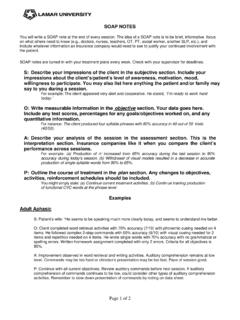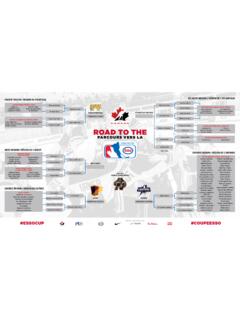Transcription of Overview of Learning Styles - Lamar University
1 Overview of Learning Styles Many people recognize that each person prefers different Learning Styles and techniques. Learning Styles group common ways that people learn. Everyone has a mix of Learning Styles . Some people may find that they have a dominant style of Learning , with far less use of the other Styles . Others may find that they use different Styles in different circumstances. There is no right mix. Nor are your Styles fixed. You can develop ability in less dominant Styles , as well as further develop Styles that you already use well.
2 Using multiple Learning Styles and multiple intelligences for Learning is a relatively new approach. This approach is one that educators have only recently started to recognize. Traditional schooling used (and continues to use) mainly linguistic and logical teaching methods. It also uses a limited range of Learning and teaching techniques. Many schools still rely on classroom and book-based teaching, much repetition, and pressured exams for reinforcement and review. A result is that we often label those who use these Learning Styles and techniques as bright.
3 Those who use less favored Learning Styles often find themselves in lower classes, with various not-so-complimentary labels and sometimes lower quality teaching. This can create positive and negative spirals that reinforce the belief that one is smart or dumb.. By recognizing and understanding your own Learning Styles , you can use techniques better suited to you. This improves the speed and quality of your Learning . The Learning Styles are: Visual (spatial). You prefer using pictures, images, and spatial understanding.
4 Aural (auditory-musical). You prefer using sound and music. Verbal (linguistic). You prefer using words, both in speech and writing. Physical (kinesthetic). You prefer using your body, hands and sense of touch. Logical (mathematical). You prefer using logic, reasoning and systems. Social (interpersonal). You prefer to learn in groups or with other people. Solitary (intrapersonal). You prefer to work alone and use self-study. Why Learning Styles ? Understand the basis of Learning Styles . Your Learning Styles have more influence than you may realize.
5 Your preferred Styles guide the way you learn. They also change the way you internally represent experiences, the way you recall information, and even the words you choose. We explore more of these features in this chapter. Research shows us that each Learning style uses different parts of the brain. By involving more of the brain during Learning , we remember more of what we learn. Researchers using brain-imaging technologies have been able to find out the key areas of the brain responsible for each Learning style.
6 For example: Visual. The occipital lobes at the back of the brain manage the visual sense. Both the occipital and parietal lobes manage spatial orientation. Aural. The temporal lobes handle aural content. The right temporal lobe is especially important for music. Verbal. The temporal and frontal lobes, especially two specialized areas called Broca's and Wernicke's areas (in the left hemisphere of these two lobes). Physical. The cerebellum and the motor cortex (at the back of the frontal lobe). handle much of our physical movement.
7 Logical. The parietal lobes, especially the left side, drive our logical thinking. Social. The frontal and temporal lobes handle much of our social activities. The limbic system (not shown apart from the hippocampus) also influences both the social and solitary Styles . The limbic system has a lot to do with emotions, moods and aggression. Solitary. The frontal and parietal lobes, and the limbic system, are also active with this style. The visual (spatial) Learning style If you use the visual style, you prefer using images, pictures, colors, and maps to organize information and communicate with others.
8 You can easily visualize objects, plans and outcomes in your mind's eye. You also have a good spatial sense, which gives you a good sense of direction. You can easily find your way around using maps, and you rarely get lost. When you walk out of an elevator, you instinctively know which way to turn. The whiteboard is a best friend (or would be if you had access to one). You love drawing, scribbling and doodling, especially with colors. You typically have a good dress sense and color balance (although not always!).
9 The aural (auditory-musical-rhythmic) Learning style If you use the aural style, you like to work with sound and music. You have a good sense of pitch and rhythm. You typically can sing, play a musical instrument, or identify the sounds of different instruments. Certain music invokes strong emotions. You notice the music playing in the background of movies, TV shows and other media. You often find yourself humming or tapping a song or jingle, or a theme or jingle pops into your head without prompting. The verbal (linguistic) Learning style The verbal style involves both the written and spoken word.
10 If you use this style, you find it easy to express yourself, both in writing and verbally. You love reading and writing. You like playing on the meaning or sound of words, such as in tongue twisters, rhymes, limericks and the like. You know the meaning of many words, and regularly make an effort to find the meaning of new words. You use these words, as well as phrases you have picked up recently, when talking to others. The physical (bodily-kinesthetic) Learning style If the physical style is more like you, it's likely that you use your body and sense of touch to learn about the world around you.
















